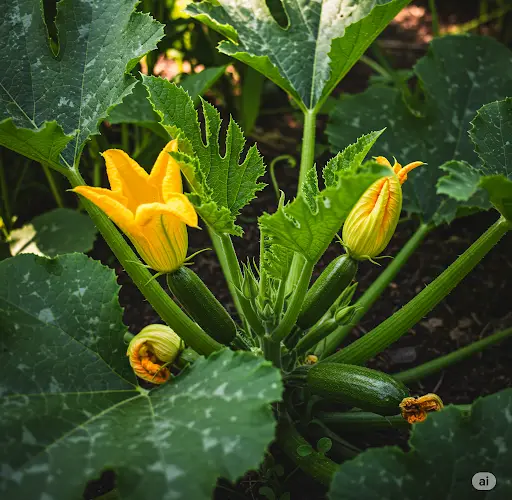Zucchini is a popular summer vegetable known for its prolific growth and delicious, versatile fruit. However, one common problem gardeners face is their zucchini plants turning yellow before the fruit is fully mature. Yellowing leaves or fruits can be alarming, but understanding the causes and taking quick action can help save your harvest and keep your plants healthy.
This article will explore the most common reasons zucchini plants turn yellow and provide effective solutions to restore your plants and maximize your crop.
Understanding Why Zucchini Turns Yellow
Yellowing in zucchini plants can affect both the leaves and the fruits, and each has different underlying causes. Identifying the specific issue is the first step toward an effective fix.
Common Causes of Yellow Leaves
1. Water Stress
Both overwatering and underwatering can cause yellow leaves. Zucchini needs consistent moisture but not soggy soil.
-
Overwatering leads to root rot and oxygen deprivation, causing leaves to yellow and wilt.
-
Underwatering causes drought stress, leading to yellowing and leaf drop.
How to fix it:
Water deeply once or twice a week, depending on weather and soil type. Ensure soil drains well and avoid water pooling around roots.
2. Nutrient Deficiency
Yellow leaves can indicate nutrient shortages, particularly nitrogen, magnesium, or iron.
-
Nitrogen deficiency causes uniform yellowing, especially in older leaves.
-
Magnesium deficiency results in yellowing between leaf veins.
-
Iron deficiency causes yellowing in younger leaves.
How to fix it:
Apply a balanced fertilizer rich in nitrogen and micronutrients. Organic options like compost or well-rotted manure also improve soil fertility.
3. Pest and Disease Issues
Pests such as aphids, squash bugs, and spider mites suck plant sap, weakening the plant and causing yellow spots or patches. Diseases like powdery mildew or bacterial wilt also cause yellowing.
How to fix it:
Inspect plants regularly. Remove pests by hand or use insecticidal soap. Remove infected leaves and improve air circulation to reduce disease spread.
Why Zucchini Fruits Turn Yellow
1. Overripe Fruits
Sometimes yellowing fruit simply means the zucchini is overripe. When left too long on the vine, zucchinis can lose their bright green color and turn yellow or pale.
How to fix it:
Harvest zucchinis when they are about 6 to 8 inches long. Frequent picking encourages more fruit production.
2. Poor Pollination
Zucchini plants rely on bees and other pollinators to produce healthy fruit. Poor pollination can cause fruits to yellow, shrivel, or develop poorly.
How to fix it:
Encourage pollinators by planting flowers nearby and avoiding pesticides. Hand-pollinate flowers by transferring pollen from male to female flowers with a small brush if necessary.
3. Sunscald
Intense direct sunlight can cause yellow, sunken patches on zucchini fruits, known as sunscald.
How to fix it:
Provide shade during the hottest parts of the day with shade cloth or plant companion crops nearby to create some shelter.
Best Practices to Save Your Zucchini Harvest
1. Monitor Soil Moisture
Use a soil moisture meter or simply check by feeling the soil. Water when the top 2 inches feel dry, aiming for deep watering to encourage strong roots.
2. Feed Your Plants Regularly
Apply a balanced fertilizer every 3-4 weeks during the growing season. Supplement with compost tea or organic fertilizers for steady nutrient supply.
3. Improve Soil Health
Add organic matter yearly to improve drainage, fertility, and microbial activity. Healthy soil supports vigorous plants resistant to stress and disease.
4. Practice Good Garden Hygiene
Remove yellow or diseased leaves promptly to prevent spreading. Clear fallen debris and rotate crops annually to avoid soil-borne diseases.
5. Encourage Beneficial Insects
Ladybugs, lacewings, and predatory mites help control pests naturally. Avoid broad-spectrum insecticides that harm these helpful allies.
6. Proper Plant Spacing
Avoid overcrowding by planting zucchini 24 to 36 inches apart. Good spacing increases airflow and reduces disease risk.
When Yellowing Persists
If yellowing continues despite proper care, consider testing your soil for pH imbalance or nutrient deficiencies. Extreme pH can lock out nutrients, making them unavailable to plants. Adjust soil pH with lime (to raise pH) or sulfur (to lower pH) based on test results.
Final Thoughts
Yellowing zucchini plants don’t have to mean disaster. By diagnosing the cause and adjusting watering, fertilizing, pest control, and harvesting practices, you can restore plant health and save your harvest.
With attentive care, your zucchini patch will thrive, providing fresh, flavorful fruits throughout the growing season.



